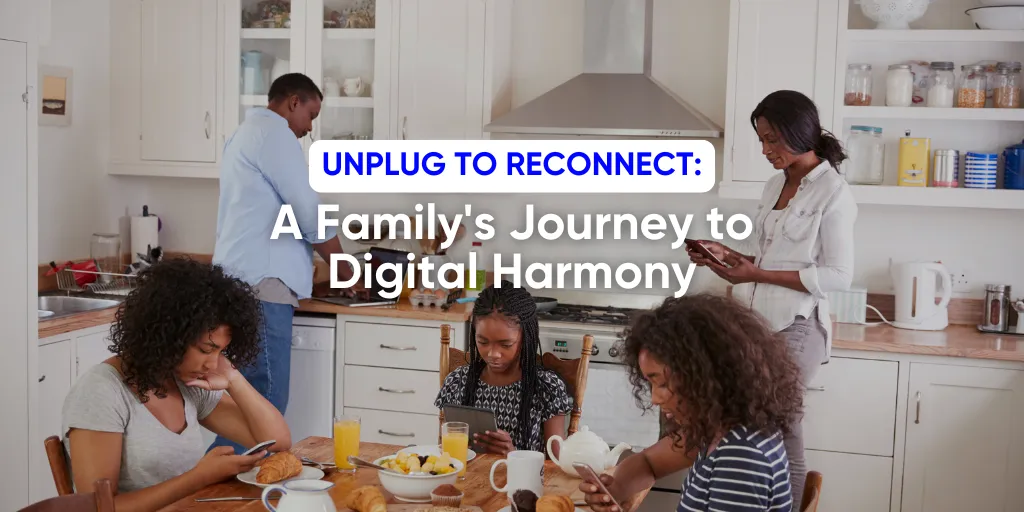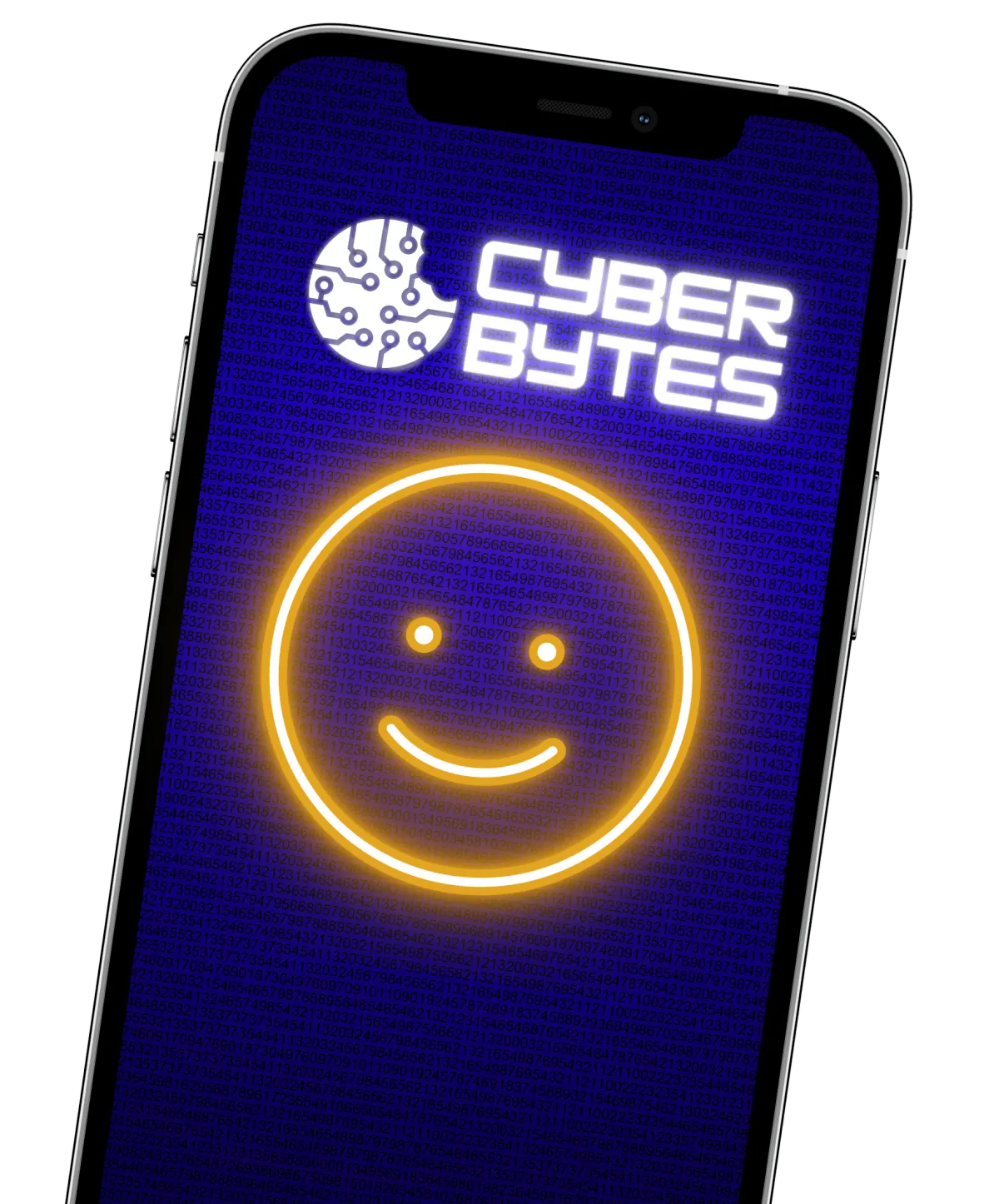You are what you click!
Learn how to make cybersecurity your way of life in an easy and guided way.
You are what you click!
Become Cyber savvy
EXPLORE BLOG BELOW
You are what you click!
Become Cyber savvy
You are what you click!
Become Cyber savvy
You are what you click!
Become Cyber savvy

Unplug to Reconnect: A Family's Journey to Digital Harmony - Copy
In an era where screens dominate our daily lives, the Johnsons found themselves at a crossroads. Like many modern families, they were grappling with the omnipresence of technology in their home. Smartphones buzzed incessantly, tablets glowed well into the night, and laptops hummed with the constant stream of work and social media. The family's story of digital overwhelm is not unique, but their journey to reclaim connection and balance offers a beacon of hope for others navigating the complex waters of our hyper-connected world.
Recognizing the Digital Dilemma
Sarah Johnson, a marketing executive, and her husband Tom, a software engineer, had always prided themselves on being tech-savvy parents. They believed that exposing their children, 12-year-old Emma and 9-year-old Ethan, to the latest technology would prepare them for the future. However, as months turned into years, they began to notice subtle yet concerning changes in their family dynamics.
Family dinners, once a cherished time for sharing and laughter, had devolved into a silent affair with each member hunched over their respective devices. Weekend outings were punctuated by constant photo-taking and social media updates, rather than genuine engagement with their surroundings. Even bedtime stories, a sacred ritual, were being replaced by the glow of iPad screens.
The turning point came during a particularly tense family vacation. As they sat on a beautiful beach, Sarah realized that instead of building sandcastles or splashing in the waves, each family member was absorbed in their digital world. The irony of traveling thousands of miles only to remain mentally tethered to their everyday digital lives hit her hard. It was then that Sarah and Tom decided it was time for a change.
Implementing 'Tech-Free' Zones and Times
The Johnsons' first step towards digital harmony was to create physical and temporal spaces free from technology's grip. They designated the dining room as a strictly device-free zone, ensuring that mealtimes once again became opportunities for face-to-face interaction. The change was met with initial resistance, especially from the children, but the family soon rediscovered the joy of uninterrupted conversations.
Next, they instituted a 'digital sunset' – a time each evening when all devices were turned off and placed in a centralized charging station. This not only improved their sleep patterns but also created a peaceful window for family bonding before bedtime. Board games, which had long gathered dust on shelves, were brought out, sparking friendly competition and laughter.
Weekend mornings, once spent in isolated screen time, were reimagined as 'adventure mornings.' The family would choose an outdoor activity – hiking, biking, or exploring a new part of their city – with a strict no-phone policy (save for emergencies). These outings not only improved their physical health but also strengthened their emotional connections.
The most challenging, yet ultimately rewarding, change was the implementation of 'Tech Tuesdays.' Every Tuesday evening, instead of retreating to separate rooms with individual devices, the family would gather to explore technology together. This structured approach to tech use allowed for shared learning experiences and opened up important discussions about the role of technology in their lives.

Introducing Cybersecurity as a Family Activity
As the Johnsons worked to redefine their relationship with technology, they recognized an opportunity to address an often-overlooked aspect of digital life: cybersecurity. Tom, drawing on his expertise as a software engineer, spearheaded this initiative, turning it into an engaging family activity.
They began with the basics, discussing the importance of strong, unique passwords. The children were fascinated to learn about password managers and even turned creating complex passphrases into a game. Emma, showing a particular interest, started keeping a journal of creative passphrases, each telling a mini-story that was easy for her to remember but difficult for others to guess.
The family also delved into the world of privacy settings on social media platforms. Together, they reviewed and adjusted their online profiles, with Sarah and Tom using the opportunity to discuss the long-term implications of digital footprints. Ethan, initially resistant to reducing his gaming time, became more receptive when he understood the security risks associated with certain online interactions.
One of the most impactful activities was a 'phishing expedition' where Tom created mock phishing emails, and the family worked together to identify red flags. This not only sharpened their critical thinking skills but also fostered a sense of teamwork in face of digital threats.
The Johnsons even extended their newfound cybersecurity awareness to their extended family, hosting a 'Digital Safety Night' for grandparents, aunts, and uncles. This intergenerational knowledge sharing not only improved the family's overall digital security but also bridged generational gaps, with children teaching adults and vice versa.
Positive Changes Observed
As weeks turned into months, the Johnsons began to notice significant positive changes in their family dynamics and individual well-being. The most immediate impact was on their sleep quality. With devices banished from bedrooms, both children and adults reported falling asleep faster and waking up more refreshed.
Emma, once constantly anxious about her social media presence, showed a marked improvement in her self-esteem. She found new confidence in her offline relationships and rediscovered her passion for painting, spending hours in creative pursuits rather than scrolling through Instagram.
Ethan's teachers reported an improvement in his focus and attention span at school. His grades improved, particularly in subjects that required sustained concentration. At home, he became more engaged in family activities, often being the one to suggest new board games or outdoor adventures.
Sarah and Tom found that their own relationship had been rekindled. Evening walks, sans phones, became a cherished ritual where they could discuss their days, share concerns, and plan for the future without digital distractions. They also noticed a decrease in work-related stress, having set clearer boundaries between their professional and personal lives.
Perhaps most importantly, the family's emotional intelligence seemed to flourish. With more face-to-face interactions, they became more attuned to each other's non-verbal cues and emotional states. Conflicts, when they arose, were resolved more quickly and compassionately, as family members were more present and attentive to each other's needs.

The Ripple Effect: Inspiring Others
The Johnsons' journey towards digital harmony did not go unnoticed. Friends and neighbors, intrigued by the visible changes in the family's dynamics, began to inquire about their 'secret.' Sarah started a blog documenting their experiences, which quickly gained a following among parents struggling with similar issues.
The family's story caught the attention of local media, leading to interviews and community workshops on digital wellness. Emma and Ethan, once reluctant participants in the family's tech experiment, became enthusiastic advocates, speaking at their schools about the benefits of balanced technology use.
Tom's workplace took notice as well, implementing some of the family's strategies to promote better work-life balance among employees. This included 'no-email Fridays' and encouraged face-to-face meetings instead of relying solely on digital communication.
Conclusion: The Importance of Intentional Tech Use
The Johnsons' journey from digital overload to tech-life balance is more than just a heartwarming family tale; it's a blueprint for intentional living in the digital age. Their story illustrates that technology, when used mindfully, can enhance rather than detract from our lives and relationships.
The key lessons from their experience are clear: establish tech-free zones and times, engage with technology as a family, prioritize cybersecurity, and remain flexible in your approach. It's not about completely eschewing technology, but rather about becoming active managers of our digital lives instead of passive consumers.
As we navigate an increasingly digital world, the Johnsons' story reminds us of the importance of human connection. It challenges us to look up from our screens, engage with the world around us, and foster meaningful relationships. In doing so, we can create a future where technology serves as a tool for connection and growth, rather than a barrier to genuine human interaction.
The path to digital harmony is not always smooth, and it requires ongoing effort and adjustment. But as the Johnsons discovered, the rewards – stronger family bonds, improved well-being, and a more balanced life – are immeasurable. Their journey invites us all to reflect on our own digital habits and take steps towards a more intentional, connected way of living in our tech-saturated world.
Live Happily Ever Cyber!

Sandra Estok
Subscribe for more ways to protect what matters most to you against hackers, scammers, and Cybermonsters™
Latest blog posts:

Unplug to Reconnect: A Family's Journey to Digital Harmony - Copy
In an era where screens dominate our daily lives, the Johnsons found themselves at a crossroads. Like many modern families, they were grappling with the omnipresence of technology in their home. Smartphones buzzed incessantly, tablets glowed well into the night, and laptops hummed with the constant stream of work and social media. The family's story of digital overwhelm is not unique, but their journey to reclaim connection and balance offers a beacon of hope for others navigating the complex waters of our hyper-connected world.
Recognizing the Digital Dilemma
Sarah Johnson, a marketing executive, and her husband Tom, a software engineer, had always prided themselves on being tech-savvy parents. They believed that exposing their children, 12-year-old Emma and 9-year-old Ethan, to the latest technology would prepare them for the future. However, as months turned into years, they began to notice subtle yet concerning changes in their family dynamics.
Family dinners, once a cherished time for sharing and laughter, had devolved into a silent affair with each member hunched over their respective devices. Weekend outings were punctuated by constant photo-taking and social media updates, rather than genuine engagement with their surroundings. Even bedtime stories, a sacred ritual, were being replaced by the glow of iPad screens.
The turning point came during a particularly tense family vacation. As they sat on a beautiful beach, Sarah realized that instead of building sandcastles or splashing in the waves, each family member was absorbed in their digital world. The irony of traveling thousands of miles only to remain mentally tethered to their everyday digital lives hit her hard. It was then that Sarah and Tom decided it was time for a change.
Implementing 'Tech-Free' Zones and Times
The Johnsons' first step towards digital harmony was to create physical and temporal spaces free from technology's grip. They designated the dining room as a strictly device-free zone, ensuring that mealtimes once again became opportunities for face-to-face interaction. The change was met with initial resistance, especially from the children, but the family soon rediscovered the joy of uninterrupted conversations.
Next, they instituted a 'digital sunset' – a time each evening when all devices were turned off and placed in a centralized charging station. This not only improved their sleep patterns but also created a peaceful window for family bonding before bedtime. Board games, which had long gathered dust on shelves, were brought out, sparking friendly competition and laughter.
Weekend mornings, once spent in isolated screen time, were reimagined as 'adventure mornings.' The family would choose an outdoor activity – hiking, biking, or exploring a new part of their city – with a strict no-phone policy (save for emergencies). These outings not only improved their physical health but also strengthened their emotional connections.
The most challenging, yet ultimately rewarding, change was the implementation of 'Tech Tuesdays.' Every Tuesday evening, instead of retreating to separate rooms with individual devices, the family would gather to explore technology together. This structured approach to tech use allowed for shared learning experiences and opened up important discussions about the role of technology in their lives.

Introducing Cybersecurity as a Family Activity
As the Johnsons worked to redefine their relationship with technology, they recognized an opportunity to address an often-overlooked aspect of digital life: cybersecurity. Tom, drawing on his expertise as a software engineer, spearheaded this initiative, turning it into an engaging family activity.
They began with the basics, discussing the importance of strong, unique passwords. The children were fascinated to learn about password managers and even turned creating complex passphrases into a game. Emma, showing a particular interest, started keeping a journal of creative passphrases, each telling a mini-story that was easy for her to remember but difficult for others to guess.
The family also delved into the world of privacy settings on social media platforms. Together, they reviewed and adjusted their online profiles, with Sarah and Tom using the opportunity to discuss the long-term implications of digital footprints. Ethan, initially resistant to reducing his gaming time, became more receptive when he understood the security risks associated with certain online interactions.
One of the most impactful activities was a 'phishing expedition' where Tom created mock phishing emails, and the family worked together to identify red flags. This not only sharpened their critical thinking skills but also fostered a sense of teamwork in face of digital threats.
The Johnsons even extended their newfound cybersecurity awareness to their extended family, hosting a 'Digital Safety Night' for grandparents, aunts, and uncles. This intergenerational knowledge sharing not only improved the family's overall digital security but also bridged generational gaps, with children teaching adults and vice versa.
Positive Changes Observed
As weeks turned into months, the Johnsons began to notice significant positive changes in their family dynamics and individual well-being. The most immediate impact was on their sleep quality. With devices banished from bedrooms, both children and adults reported falling asleep faster and waking up more refreshed.
Emma, once constantly anxious about her social media presence, showed a marked improvement in her self-esteem. She found new confidence in her offline relationships and rediscovered her passion for painting, spending hours in creative pursuits rather than scrolling through Instagram.
Ethan's teachers reported an improvement in his focus and attention span at school. His grades improved, particularly in subjects that required sustained concentration. At home, he became more engaged in family activities, often being the one to suggest new board games or outdoor adventures.
Sarah and Tom found that their own relationship had been rekindled. Evening walks, sans phones, became a cherished ritual where they could discuss their days, share concerns, and plan for the future without digital distractions. They also noticed a decrease in work-related stress, having set clearer boundaries between their professional and personal lives.
Perhaps most importantly, the family's emotional intelligence seemed to flourish. With more face-to-face interactions, they became more attuned to each other's non-verbal cues and emotional states. Conflicts, when they arose, were resolved more quickly and compassionately, as family members were more present and attentive to each other's needs.

The Ripple Effect: Inspiring Others
The Johnsons' journey towards digital harmony did not go unnoticed. Friends and neighbors, intrigued by the visible changes in the family's dynamics, began to inquire about their 'secret.' Sarah started a blog documenting their experiences, which quickly gained a following among parents struggling with similar issues.
The family's story caught the attention of local media, leading to interviews and community workshops on digital wellness. Emma and Ethan, once reluctant participants in the family's tech experiment, became enthusiastic advocates, speaking at their schools about the benefits of balanced technology use.
Tom's workplace took notice as well, implementing some of the family's strategies to promote better work-life balance among employees. This included 'no-email Fridays' and encouraged face-to-face meetings instead of relying solely on digital communication.
Conclusion: The Importance of Intentional Tech Use
The Johnsons' journey from digital overload to tech-life balance is more than just a heartwarming family tale; it's a blueprint for intentional living in the digital age. Their story illustrates that technology, when used mindfully, can enhance rather than detract from our lives and relationships.
The key lessons from their experience are clear: establish tech-free zones and times, engage with technology as a family, prioritize cybersecurity, and remain flexible in your approach. It's not about completely eschewing technology, but rather about becoming active managers of our digital lives instead of passive consumers.
As we navigate an increasingly digital world, the Johnsons' story reminds us of the importance of human connection. It challenges us to look up from our screens, engage with the world around us, and foster meaningful relationships. In doing so, we can create a future where technology serves as a tool for connection and growth, rather than a barrier to genuine human interaction.
The path to digital harmony is not always smooth, and it requires ongoing effort and adjustment. But as the Johnsons discovered, the rewards – stronger family bonds, improved well-being, and a more balanced life – are immeasurable. Their journey invites us all to reflect on our own digital habits and take steps towards a more intentional, connected way of living in our tech-saturated world.
Live Happily Ever Cyber!

Sandra Estok
Subscribe for more ways to protect what matters most to you against hackers, scammers, and Cybermonsters™
Stop Hackers, Scammers and Cybermonsters in their tracks.
Take charge of your Cyber Life today!
Push Cybermonsters away from your private data.
Subscribe to my newsletter about cybersecurity and cyber safety. New issues every Tuesday.




